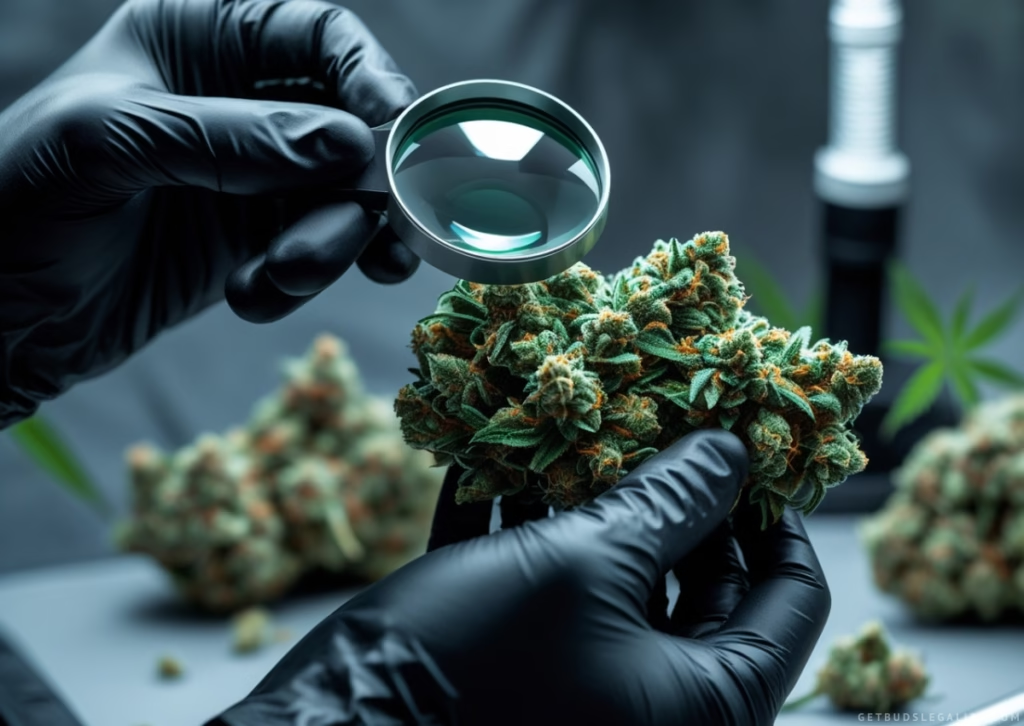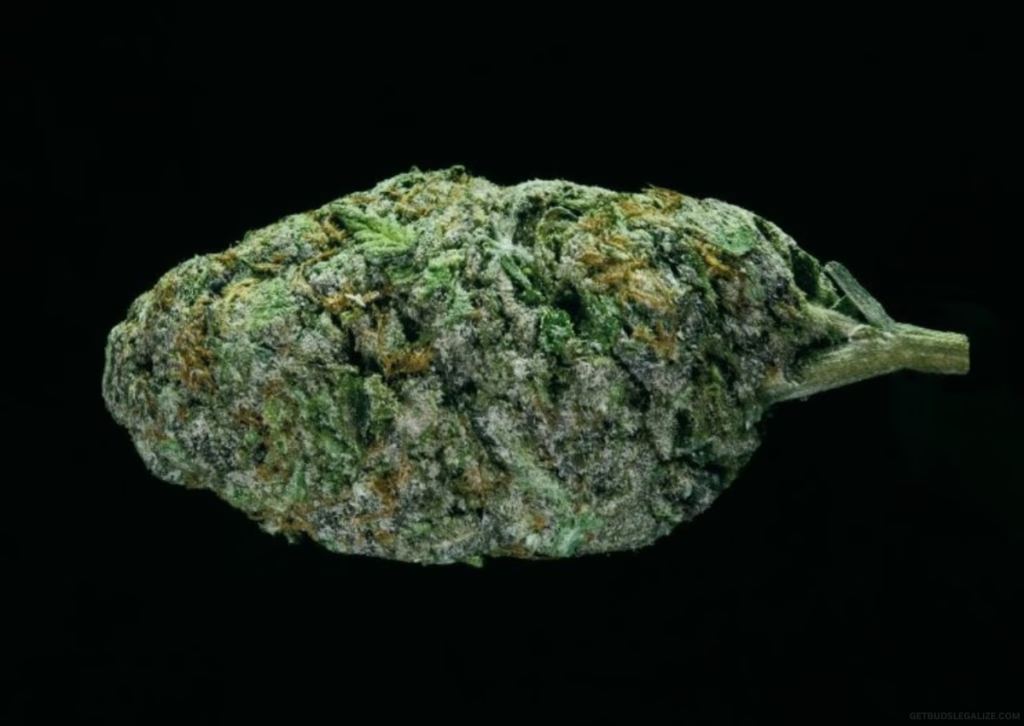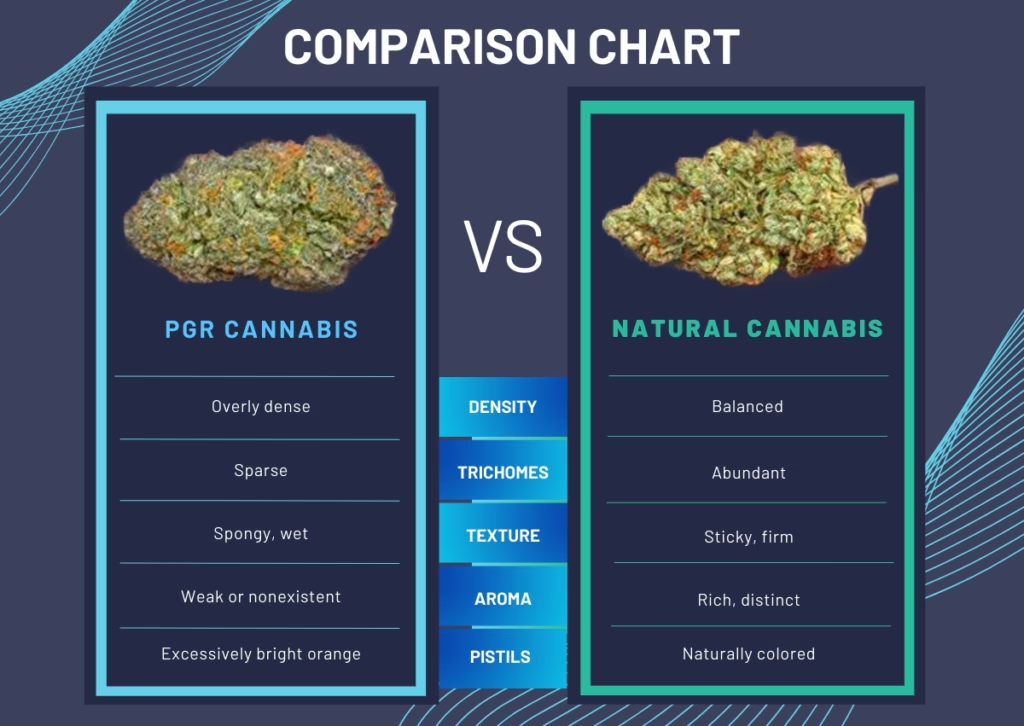What Are PGRs in Weed Plants, And Why Should You Care?
Ever bought cannabis that looked flawless—rock-hard, covered in bright orange hairs, but oddly lacking in smell and potency? If so, you might have encountered PGR weed.
Some growers use plant growth regulators (PGRs), the same chemicals designed for golf course turf—to bulk up their buds. The result? Dense, heavy nugs that look premium but come at a hidden cost: weaker potency, dull flavor, and potential health risks.
While PGRs are common in agriculture, their use in cannabis is controversial. Consumers seeking pure, high-quality weed need to understand the risks these chemicals pose and how to avoid them.
Let’s break down what PGRs are, why some growers use them, and how to spot fake “top-shelf” buds before you buy.
What Are PGRs and How Do They Work?
Plant growth regulators (PGRs) are compounds that influence plant growth. They can be naturally occurring or synthetic and play a role in everything from root development to flowering and fruit production.
Natural vs Synthetic PGRs
Natural PGRs help plants grow in a balanced, healthy way:
- Abscisic Acid: Helps plants retain water during drought.
- Ethylene: Facilitates fruit ripening.
- Gibberellin: Aids germination and growth.
- Auxin: Stimulates root development.
- Cytokinins: Promote cell division and delay aging.
Synthetic PGRs, on the other hand, are designed to enhance certain characteristics, often resulting in unnaturally dense, compact buds. This might be appealing to growers, but it can negatively impact the cannabis experience for consumers.

Why Growers Use PGRs in Cannabis (And Why You Should Be Concerned)
Not all growers prioritize quality over quantity. Some turn to plant growth regulators (PGRs) to boost their yield, making buds look more appealing and increasing profits. But this shortcut comes with significant downsides for consumers.
Why Do Growers Use PGRs?
- Larger Buds: PGRs bulk up cannabis flowers unnaturally, creating dense, rock-hard nugs.
- Faster Growth: Shortened growth cycles allow for quicker harvests, increasing revenue.
- Higher Yields: More weight per plant means bigger profits.
The Problem for Consumers
- Lower Potency: PGR cannabis contains less THC and CBD, leading to weaker effects.
- Diminished Flavor & Aroma: Essential terpenes are reduced, resulting in a bland taste and faint smell.
- Health Risks: Some synthetic PGRs have been linked to toxicity, hormone disruption, and even cancer risks.
PGR cannabis may look appealing, but its quality suffers. Consumers seeking pure, flavorful, and effective cannabis should learn how to identify and avoid PGR-treated buds.
How PGRs Affect Cannabis Plants: The Good, The Bad, and The Toxic
PGRs function similarly to hormones in humans, influencing growth and development. However, synthetic PGRs often disrupt a plant’s natural chemistry, leading to:
- Diminished cannabinoid production (less THC, CBD, etc.)
- Altered chemical balance (affecting medicinal properties)
- Compromised sustainability (environmental impact from chemical runoff)
The Hidden Costs of PGR Weed: Is It Worth the Risk?
At first glance, PGR cannabis may seem like a great deal—dense buds, bright colors, and heavy nugs. But beyond appearance, it often fails to deliver the quality and experience that consumers expect.
How PGRs Impact Cannabis Quality
- Weaker High: Reduced cannabinoid levels lead to mild, short-lived effects.
- Inferior Smoke: Many users report harshness, excessive ash, and a poor burn quality.
- Unnatural Texture: Buds can feel spongy, overly dense, or moist—far from the ideal cure.
Are the Risks Worth It?
If you value potency, smooth smoke, and authentic flavors, then PGR weed is not worth the trade-off. Instead, opt for naturally grown, lab-tested cannabis that prioritizes purity over artificial bulk.

Are PGRs Dangerous? Health Risks You Need to Know
While some PGRs are approved for agricultural use, others have been banned due to safety concerns.
Studies suggest that prolonged exposure to certain synthetic PGRs may cause significant health risks.
Problematic Synthetic PGRs in Cannabis:
- Paclobutrazol: Linked to reproductive health issues and developmental problems in animals. It also lingers in soil, affecting future crops and ecosystems.
- Chlormequat Chloride: Can cause lung irritation and nausea. Long-term exposure has been associated with liver damage and hormonal disruptions.
- Daminozide: A probable human carcinogen, banned in the U.S. due to cancer risks. When burned, it can form highly toxic and carcinogenic nitrosamines.
PGRs and the Environment: What’s the Long-Term Damage?
Beyond personal health risks, synthetic PGRs have lasting effects on the environment.
Soil Health:
- Declining soil fertility
- Reduced biodiversity
- Harmed microbial communities
Aquatic Ecosystems:
- Runoff from PGR-treated crops can contaminate water bodies, harming fish and aquatic species.
- Certain PGRs, like paclobutrazol, bioaccumulate, persist in the food chain.
How to Identify PGR Weed: A Guide for Consumers
Want to avoid synthetic PGR-treated cannabis? Look for these warning signs:
Red Flags:
- Dense, Rock-Hard Buds → PGR weed is unnaturally thick and heavy.
- Lack of Trichomes → Reduced frostiness, meaning lower potency and aroma.
- Unusual Texture → Spongy, damp, or unnaturally firm.
- Weak Aroma → PGR weed lacks terpenes, resulting in little to no smell.
- Excessively Bright Orange Pistils → A sign of chemical interference.

PGRs Weed vs Natural: Side-by-Side Comparison
| Feature | Natural Cannabis | PGR Cannabis |
| Density | Balanced | Overly dense |
| Trichomes | Abundant | Sparse |
| Texture | Sticky, firm | Spongy, wet |
| Aroma | Rich, distinct | Weak or nonexistent |
| Pistils | Naturally colored | Excessively bright orange |
Say No to PGR Weed: Why Growing Your Own Might Be the Best Choice
With the rise of PGR-treated cannabis, many consumers are turning to home cultivation. Growing your own ensures:
- Full control over plant health and quality
- No exposure to harmful synthetic chemicals
- The ability to enjoy natural, flavorful cannabis
If home growing isn’t an option, seek out dispensaries that provide lab-tested, organic products.
Conclusion: Make Informed Choices, Support Clean Cannabis
PGR weed may have an attractive appearance, but its hidden risks far outweigh any perceived benefits. Opting for natural, high-quality cannabis and supporting ethical growers contributes to a healthier, more sustainable industry.
How do you feel about PGR weed?
Share your thoughts on our Facebook page and join the conversation! Don’t forget to subscribe to our email list for the latest updates, tips, and cannabis industry news.
Frequently Asked Questions (FAQs) about PGRs in Marijuana Plants
PGRs, or plant growth regulators, are chemical compounds used to influence plant growth, structure, and yield. They can be natural (hormones like auxins and cytokinins) or synthetic, which are often used to produce denser, larger cannabis buds but may pose health risks.
No. Natural PGRs, such as gibberellins, auxins, and cytokinins, are essential for healthy plant growth. The concern is with synthetic PGRs that can negatively impact quality and pose potential health risks.
Growers use PGRs to increase yield, speed up growth cycles, and produce visually appealing buds. However, this often comes at the cost of potency, terpene profile, and overall quality of the cannabis.
Yes, PGRs can reduce THC and CBD levels, leading to weaker psychoactive and medicinal effects. They also diminish the terpene profile, resulting in less aroma and flavor.
Some synthetic PGRs, such as paclobutrazol and daminozide, have been linked to potential health risks, including hormonal disruptions, reproductive issues, and even carcinogenic effects when burned and inhaled.
Synthetic PGRs can contaminate soil, water sources, and harm aquatic life due to chemical runoff. They can also disrupt soil microbiomes, affecting long-term agricultural sustainability.
Regulations vary by region. Some countries and states have banned certain PGRs due to health concerns, while others still allow their use in commercial agriculture, including cannabis cultivation.
Signs of PGR-treated cannabis include:
- Overly dense, rock-hard buds
- Lack of trichomes (frosty crystals)
- Weak aroma due to reduced terpene content
- Spongy, damp, or excessively firm texture
- Bright orange or reddish pistils (hairs) that seem unnatural
Some growers claim to flush synthetic PGRs from plants before harvest, but many chemicals remain in the buds, making them unsafe for consumption.
If you believe your cannabis is PGR-treated, avoid consuming it. Report concerns to local dispensaries, regulators, or cannabis testing labs to ensure consumer safety.
- Buy from reputable, organic growers
- Choose lab-tested cannabis with transparent COAs (Certificates of Analysis)
- Look for natural visual characteristics like frosty trichomes, balanced bud density, and a strong aroma
- Consider growing your own cannabis for complete control over quality
Yes! Growing your own cannabis allows you to avoid synthetic PGRs, ensuring a natural, safe product with full control over cultivation practices.
- Buy from reputable sources
- Check for lab tests
- Consider growing your own cannabis
the cannabis cultivation process. This typically includes adding chemicals like paclobutrazol, chlormequat chloride, or daminozide to the nutrient mix or soil.
These chemicals alter the plant’s growth patterns, forcing buds to become unnaturally dense and large.
However, using synthetic PGRs comes with significant risks, including lower cannabinoid content, reduced terpene levels, and potential health hazards for consumers.
Ethical and organic growers avoid these substances to prioritize quality and safety.
The PGR weed effects can significantly impact the overall cannabis experience, often leading to a subpar and potentially harmful outcome. Consuming PGR-treated cannabis can result in:
- Harsher smoke: PGR weed can be rough on the throat and lungs, causing excessive coughing and irritation.
- Weak or inconsistent high: The reduced cannabinoid content results in less pronounced psychoactive and medicinal effects.
- Unpleasant taste and aroma: PGR weed lacks the complex flavors and scents found in naturally grown cannabis.
- Increased headaches or nausea: Some consumers experience discomfort, possibly due to residual chemicals in the buds.
PGR weed long-term effects can pose serious health concerns for regular consumers. Prolonged exposure to synthetic PGRs in cannabis may lead to:
- Respiratory issues: Inhaling burned PGR-treated cannabis may introduce toxic byproducts that irritate the lungs and airways.
- Hormonal disruptions: Certain PGRs, such as paclobutrazol and chlormequat chloride, have been linked to endocrine system interference.
- Liver and kidney strain: Some synthetic PGRs accumulate in the body over time, potentially leading to organ damage.
- Increased cancer risk: Chemicals like daminozide have been classified as probable carcinogens, with potential links to long-term health complications.
Cannabis laws regarding plant growth regulators (PGRs) differ significantly from country to country. Some regions enforce strict bans due to health and environmental risks, while others allow their use with little oversight.
Staying informed about PGR regulations in your region can help you make safer purchasing decisions.
Yes, synthetic PGRs are widely used in Asian cannabis cultivation, particularly in countries like China and India. Due to high demand and cost-effective farming practices, growers often rely on these chemicals to increase yields.
However, weak regulatory enforcement raises concerns about excessive chemical use, environmental contamination, and product safety.
The U.S. Environmental Protection Agency (EPA) has banned certain hazardous PGRs, such as daminozide, due to their carcinogenic risks.
However, cannabis regulations vary by state, and in some unregulated markets, PGR-treated cannabis may still be available.
Consumers should seek lab-tested cannabis to ensure product safety.
The European Union (EU) enforces strict safety standards on plant growth regulators.
While some PGRs remain approved for agricultural use, the EU requires rigorous testing and sets limits on potentially harmful substances.
Consumer safety remains a top priority, making PGR-treated cannabis less common in legal European markets.
ILGM Fertilizer:
Feed Your Plants Right

The Ultimate Cannabis Fertilizer – designed to fuel every stage from seedling to harvest.
✅ Feeds 5+ plants
✅ Big savings with bundle
✅ Works in soil, coco, or hydro
✅ Supports bigger, healthier yields
ILGM Plant Protector:
Ultimate Cannabis Protection

Shield your plants from pests and disease—naturally and effectively.
Protect From Seedling to Harvest
✅ Protects up to 20 plants
✅ Works in soil, coco, or hydro
✅ Fights pests & diseases fast
✅ Keep your grow healthy & stress-free



















